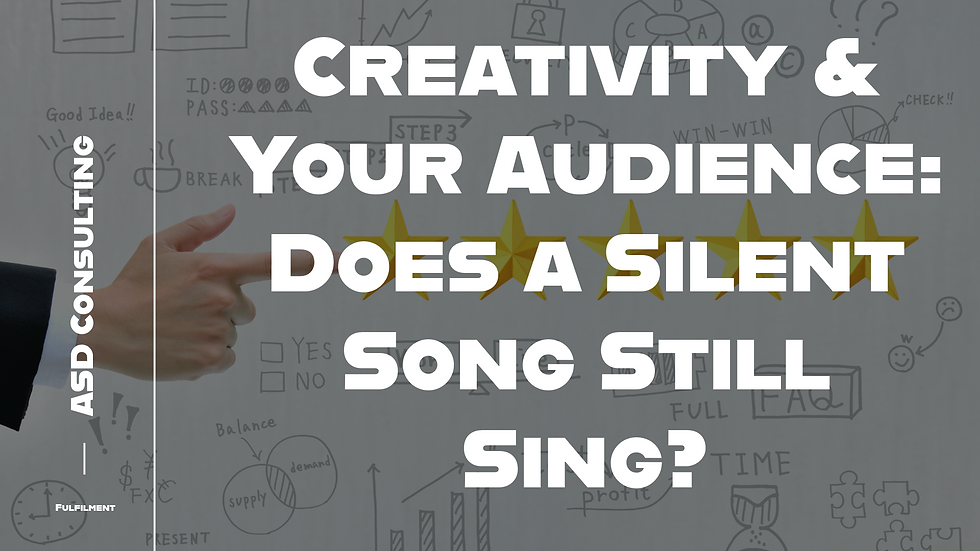Creativity & Your Audience: Does a Silent Song Still Sing? Creativity Beyond Applause!
- David Tyler

- Jul 6
- 4 min read

In my explorations of happiness, fulfilment, and the profound importance of living authentically, I've often touched upon the human spirit's innate drive to create. Whether it's crafting a solution to a complex problem, composing a piece of music, painting a canvas, or even finding an ingenious way to organise your sock drawer, creativity is a fundamental aspect of our existence. But this raises a fascinating, and perhaps provocative, question: Does "true creativity" exist without an audience to appreciate it? And what does it mean to "be creative" when your projects and activities are undertaken solely for yourself? Is it merely "fun," or something more profound? Creativity Beyond Applause! true power lies within. It's real whether shared or solo, loved or hated. Your unique spark doesn't need applause.
Society often ties creativity to public output and reception. We celebrate the artist in galleries, the musician on charts, the scientist in journals. Here, creativity is validated by its impact on an audience. Without this external gaze, does creation lose its spark, becoming mere hobby?
From a social scientific view, the audience is crucial for certain definitions. If creativity is about producing something novel and useful within a culture, then an audience judges that usefulness. They complete the creative circuit, spreading the idea and integrating it. Without them, a work might remain a private curiosity.
Philosophically, however, this external validation feels incomplete. Suggesting creativity only becomes real when witnessed diminishes the creative process itself. Is a poet writing for their eyes only less creative than a published laureate? Is a gardener cultivating a stunning landscape for personal joy less creative than a public park designer? No.
Creating for yourself is a deeply personal, often restorative act. It's more than just "fun," though it brings immense joy. It's self-expression, self-discovery, even self-healing. When you create for yourself, you tap into intrinsic motivation, free from expectations, judgment, or marketability. This freedom allows pure exploration, a willingness to experiment and "fail" without external fear.
I define "being creative for your own amusement" as unfettered engagement with novel thought, imaginative exploration, and playful manipulation of ideas or materials, for intrinsic satisfaction and personal growth. This is creativity in its purest form—a dialogue between self and idea, unburdened by external affirmation.
This private creativity is foundational. It nourishes the soul, sharpens the mind, and builds skills. The satisfaction of solving a personal design challenge, the meditative flow of spontaneous art, the thrill of developing a new philosophical concept for personal understanding—these are profound creative acts. They build cognitive flexibility, foster resilience, and provide agency and purpose, perfectly aligning with true fulfilment.
Indeed, private creativity often sparks public innovation. Artists refine their craft in solitude; scientists grapple with theories privately; writers draft unseen pages. These personal "laboratories" allow ideas to breathe, welcome mistakes, and foster authentic voices before they engage an audience.
When the Audience Hates It: The Uncomfortable Truth of Creative Expression
Now, consider the tough question: what if your work meets indifference, confusion, or outright disdain? Is something still creative if people "hate it"? Does creativity need to be liked to be real?
This forces us to separate creation from reception. Philosophically, the creative act is complete when the work comes into being. The artist has expressed; the inventor has conceived. The internal process of generating novelty is done. The audience's response, while impactful on the creator's emotions or the work's market, doesn't erase the creative process.
Art history shows this clearly. Many masterpieces faced initial ridicule. Impressionist paintings were scoffed at; early abstract art dismissed. Yet, their creative genius is now undeniable. These works were creative from day one, regardless of contemporary opinion. Their creators pushed boundaries and expressed unique visions, even if initially unwelcome.
From a social scientific view, audience rejection can reveal much about cultural norms or societal readiness for novelty. A work might be ahead of its time. But it doesn't diminish the creator's effort, insight, or imaginative leap. The creativity in the production remains, even if the product fails to resonate or actively repels.
Therefore, creativity does not require people to like it for it to be real. Positive reception is validating, but it’s not a defining trait of the creative act. The true measure of creativity lies in the novelty, intentionality, and imaginative spark that ignited it, not in fluctuating public opinion. Sometimes, the most authentic creative acts challenge, provoke, and even alienate, precisely by stepping outside the familiar.
In conclusion, while an audience is vital for creativity's social and economic impact, it's not a prerequisite for its existence. Creativity is an internal phenomenon—our human capacity to imagine, connect, innovate, and manifest meaning. Whether shared with millions or cherished by one, whether applauded or abhorred, bringing something new into being is a valuable expression of our potential. So, nurture your private creative pursuits. Let them bring joy, personal growth, and a quiet testament to the boundless inventive spirit within us, regardless of who's watching, or what they think.



Comments